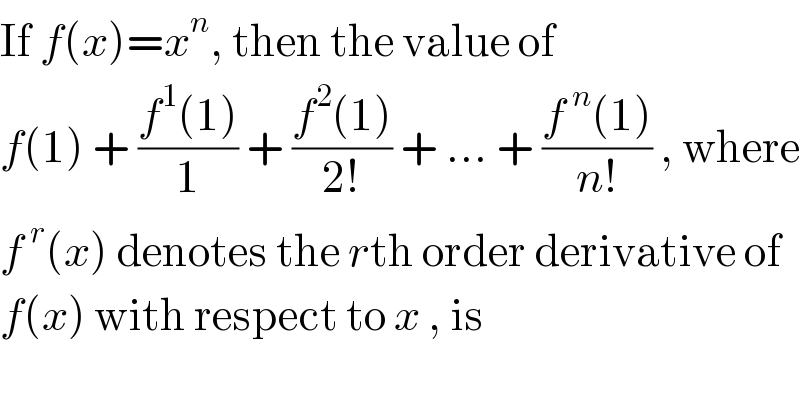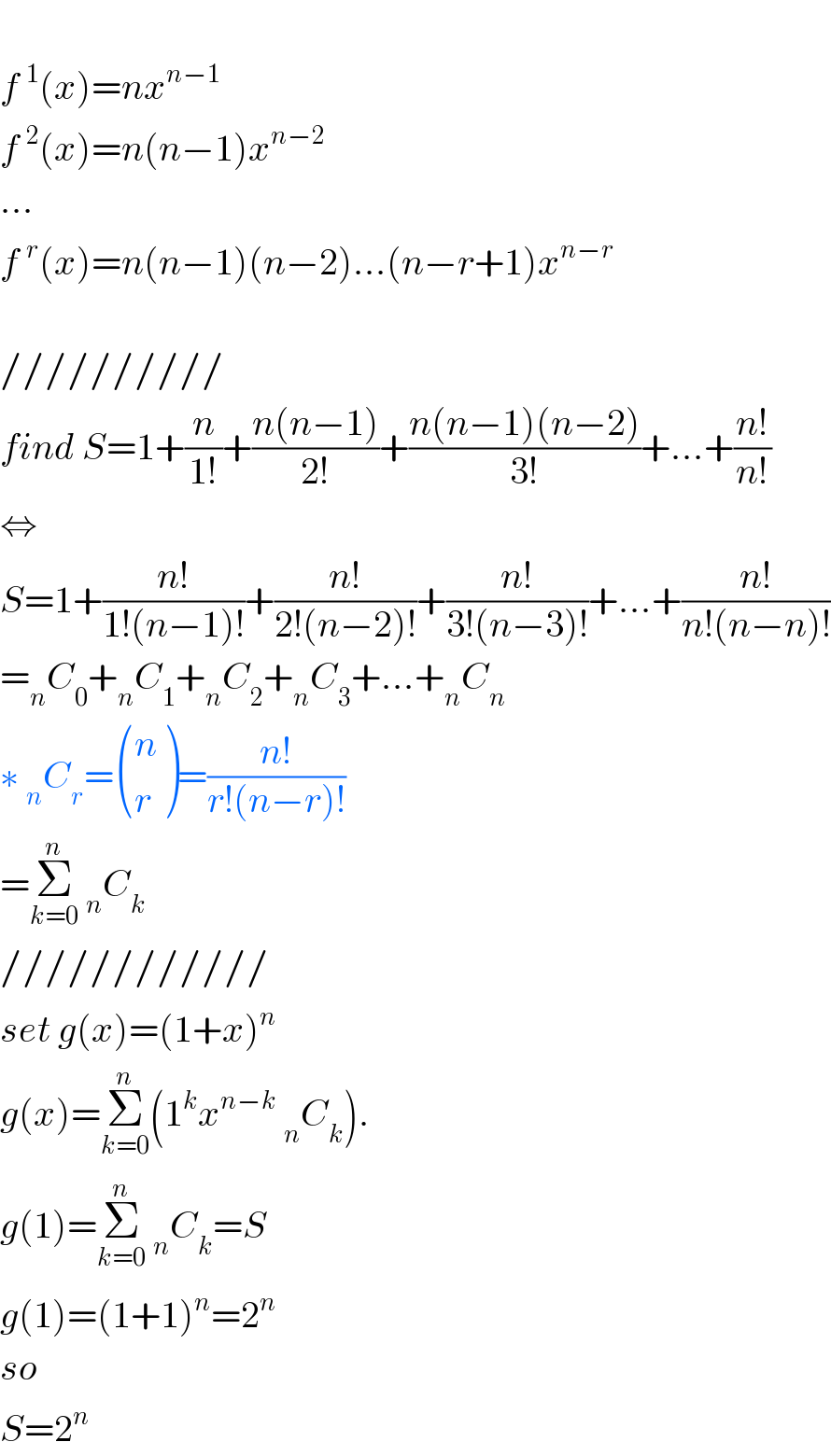Question Number 8155 by 314159 last updated on 02/Oct/16

$$\mathrm{If}\:{f}\left({x}\right)={x}^{{n}} ,\:\mathrm{then}\:\mathrm{the}\:\mathrm{value}\:\mathrm{of} \\ $$$${f}\left(\mathrm{1}\right)\:+\:\frac{{f}^{\mathrm{1}} \left(\mathrm{1}\right)}{\mathrm{1}}\:+\:\frac{{f}^{\mathrm{2}} \left(\mathrm{1}\right)}{\mathrm{2}!}\:+\:…\:+\:\frac{{f}^{\:{n}} \left(\mathrm{1}\right)}{{n}!}\:,\:\mathrm{where} \\ $$$${f}^{\:{r}} \left({x}\right)\:\mathrm{denotes}\:\mathrm{the}\:{r}\mathrm{th}\:\mathrm{order}\:\mathrm{derivative}\:\mathrm{of} \\ $$$${f}\left({x}\right)\:\mathrm{with}\:\mathrm{respect}\:\mathrm{to}\:{x}\:,\:\mathrm{is} \\ $$
Commented by sou1618 last updated on 02/Oct/16

$$ \\ $$$${f}\:^{\mathrm{1}} \left({x}\right)={nx}^{{n}−\mathrm{1}} \\ $$$${f}\:^{\mathrm{2}} \left({x}\right)={n}\left({n}−\mathrm{1}\right){x}^{{n}−\mathrm{2}} \\ $$$$… \\ $$$${f}\:^{{r}} \left({x}\right)={n}\left({n}−\mathrm{1}\right)\left({n}−\mathrm{2}\right)…\left({n}−{r}+\mathrm{1}\right){x}^{{n}−{r}} \\ $$$$ \\ $$$$////////// \\ $$$${find}\:{S}=\mathrm{1}+\frac{{n}}{\mathrm{1}!}+\frac{{n}\left({n}−\mathrm{1}\right)}{\mathrm{2}!}+\frac{{n}\left({n}−\mathrm{1}\right)\left({n}−\mathrm{2}\right)}{\mathrm{3}!}+…+\frac{{n}!}{{n}!} \\ $$$$\Leftrightarrow \\ $$$${S}=\mathrm{1}+\frac{{n}!}{\mathrm{1}!\left({n}−\mathrm{1}\right)!}+\frac{{n}!}{\mathrm{2}!\left({n}−\mathrm{2}\right)!}+\frac{{n}!}{\mathrm{3}!\left({n}−\mathrm{3}\right)!}+…+\frac{{n}!}{{n}!\left({n}−{n}\right)!} \\ $$$$=_{{n}} {C}_{\mathrm{0}} +_{{n}} {C}_{\mathrm{1}} +_{{n}} {C}_{\mathrm{2}} +_{{n}} {C}_{\mathrm{3}} +…+_{{n}} {C}_{{n}} \\ $$$$\ast\:_{{n}} {C}_{{r}} =\begin{pmatrix}{{n}}\\{{r}}\end{pmatrix}=\frac{{n}!}{{r}!\left({n}−{r}\right)!} \\ $$$$=\underset{{k}=\mathrm{0}} {\overset{{n}} {\sum}}\:_{{n}} {C}_{{k}} \\ $$$$//////////// \\ $$$${set}\:{g}\left({x}\right)=\left(\mathrm{1}+{x}\right)^{{n}} \\ $$$${g}\left({x}\right)=\underset{{k}=\mathrm{0}} {\overset{{n}} {\sum}}\left(\mathrm{1}^{{k}} {x}^{{n}−{k}} \:_{{n}} {C}_{{k}} \right). \\ $$$${g}\left(\mathrm{1}\right)=\underset{{k}=\mathrm{0}} {\overset{{n}} {\sum}}\:_{{n}} {C}_{{k}} ={S} \\ $$$${g}\left(\mathrm{1}\right)=\left(\mathrm{1}+\mathrm{1}\right)^{{n}} =\mathrm{2}^{{n}} \\ $$$${so} \\ $$$${S}=\mathrm{2}^{{n}} \\ $$
Commented by 314159 last updated on 02/Oct/16

$${Thanks}! \\ $$
Answered by prakash jain last updated on 02/Oct/16

$$\mathrm{Answer}\:\mathrm{in}\:\mathrm{comments} \\ $$
